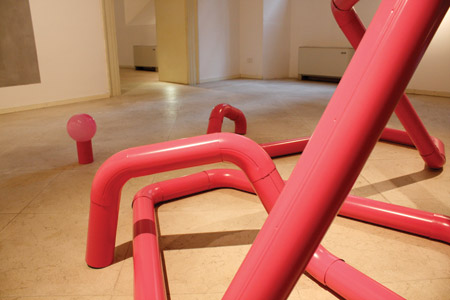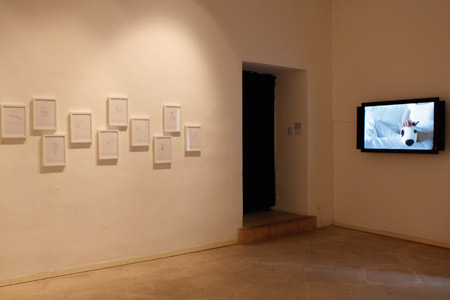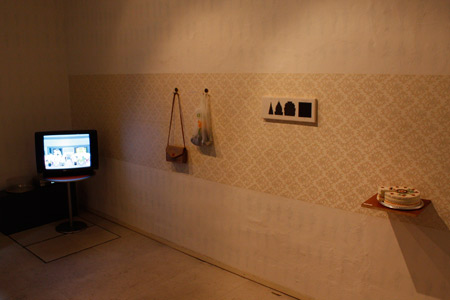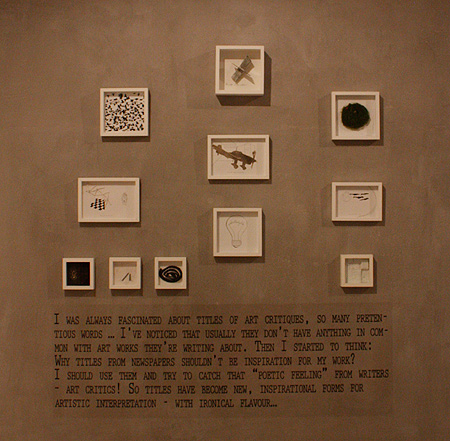|
Lost in Communication
Exhibition of the group KOLEKTIVA, Vesna Bukovec, Lada Cerar
and Metka Zupanič
January 18–February 8, 2011
Opening: Tuesday, January 18, 2011, at 6 pm
Galeria A+A, San Marco, Calle Malipiero 3073
Venice, Italy
We are informing you about the exhibition project of Vesna Bukovec, SCCA-Ljubljana's webmaster and member of art group KOLEKTIVA.
Lost in Communication
Lost in Communication is an exhibition that assembles three Slovenian artists born in the seventies and belonging to the same generation – three artists who individually pursue their own practice while working together in the group KOLEKTIVA.

KOLEKTIVA, Lost in Communication, 2010
A collective project of KOLEKTIVA, Lost in Communication (2010) features interweaving coloured tubes that chaotically invade their surrounding environment. Using modular drainpipes that can be reconstructed depending on the exhibition site, the structure can change from day to day, and in some contexts presents an audible component that emanates into the outer space from within the tubes. The drainpipe’s grey, metal surface is covered up with vibrant and cheerful colours. The installation is often accompanied by wall pieces that offer thumbnail views of alternate configurations for the drainpipes, always highlighted by their bright colours. KOLEKTIVA’s projects vary in nature, ranging from artistic production to curatorial endeavours, organizing art events characterized by their great inventiveness and realized through simple means. Initiatives have involved a vast number of artists and other participants, who have directly collaborated on projects such as Visions (2006), Special Place in the City (2004–) and Secret Heart (2010). Additionally, several projects began with open calls for proposals and submissions, allowing general public and artists to actively participate. The group has been very productive, particularly in the past year. Numerous projects have been developed contemporarily in various exhibition venues, giving rise to a widespread and networking presence that is constantly evolving.

Vesna Bukovec, Positive Illusion, 2009 and It Will Be OK, 2009
In addition to KOLEKTIVA, each artist partakes in independent practice. For some years, Vesna Bukovec has engaged herself with artistic interventions that directly involve citizens. Her work invites them to express views on issues related to community, demonstrating how the arts can interact with heterogeneous situations. Recent project, Positive Illusion (2009) probes the stock images archives on the web produced by apt designers and marketing professionals, which were conceived to represent our notions of certainty and increase our feelings of security. With a simple, black line Bukovec outlines figures, situations and settings. Details or aspects are isolated to later be transformed into representations incongruent to their original form. The procedure is opposite to the work of designers, who eliminate any traces of ideas that disrupt our notions of comfort. Bukovec, on the other hand, uses this is her point of departure, eroding the positive illusions with which we surround ourselves. These images are juxtaposed with psychological tests, typically found in insipid magazines, which assess levels of satisfaction, happiness and other values sought after by consumer society. Unlike the copy in these magazines, which tend to avoid direct questions, Bukovec poses queries that can only have a single, concrete answer.

Lada Cerar, Who is Afraid of Old People?, 2005
Lada Cerar’s socially framed work, Who is Afraid of Old People? (2005), examines a problem that plagues humanity (the increasing number of elderly people in the world), implemented by using forms of representation that exacerbate the typical characteristics inhabiting the world of the old. The beauty of a cake made of coloured pills and common use objects located in familiar settings now worn by time help to create a crescendo of anguish, reaching its climax in a selection of television clips from around the world which present old age as a disease that can be easily overcome. Staged living environments are supplemented by graphs showing an increase in the aging population, arriving at the unsettling predictions about the future by Kazimir Malevich. The contrast between these cold statistics we read in newspapers and the environment that Cerar recreates is very strong. On one hand are science and its predictions of the future, and on the other is the inevitable fate that awaits us.

Metka Zupanič, Too Many Words, 2010
Metka Zupanič’s work focuses on the processes that govern the dissemination of art work: that which is the complex network of galleries, or that of curators, journals and museums. With Too Many Words (2010), Zupanič has evaluated the titles that accompany articles in art magazines. Redundant phrases, with the sole purpose of enhancing commercial value, embrace wording is found to be without logic when analyzed. These short slogans are the starting point of Zupanič’s work, sometimes proving so excessive that they become senseless when converted into imagery. Zupanič suffuses literal meaning into the hyperbole, creating surreal representations of the sentences. The compositions that characterize the works of Too Many Words see them gather within a grey square: a defined circle, small paintings of the written words, and titles that accompany the articles of art reviews. In order to understand the artist’s intentions in some drawings, the viewer must first read these papers, whose words help us understand the representation and cause us to smile upon the relationship that develops between the word and image.
 |
KOLEKTIVA is an art group from Ljubljana, Slovenia which was established in 2008. The three members of the group Vesna Bukovec, Lada Cerar and Metka Zupanič have worked on occasional common projects since 2003. Their projects are focused on various aspects of communication, inter-personal relationships and everyday life. KOLEKTIVA has presented it’s projects in several solo exhibitions in Nottingham (2004), Zagreb (2004), Celje (2004), Graz (2006), Ljubljana (2007), Maribor (2008), Warsaw (2010) and in many international group exhibitions, such as: 11th Biennial of the Young Artists of Europe and the Mediterranean, Athens (2003); Young Art Europe, MOYA Museum of Young Art, Vienna (2005); Narratives: -35/+65, Two Generations, Museum Joanneum, Kunsthaus, Graz (2006); Some Other City, Sarevo Winter Festival, Sarajevo (2007); Berliner Liste 2009, Palais am Tiergarten, Berlin (2009); SCULPTURE TODAY. Components junctions and intersections., Gallery of Contemporary Art, Celje (2010); E-motion to cohabit, Galleria d’Arte Moderna Palazzo Forti, Verona, (2010).
www.kolektiva.org
Vesna Bukovec (1977) graduated (2002) and completed her post-graduate studies (2006) in Sculpture at the Academy of Fine Arts and Design in Ljubljana. She works independently and in the group KOLEKTIVA (with Lada Cerar and Metka Zupanič). Her artistic work finds its expression in a variety of media (video, photography, drawing, installation) and approaches (research, appropriation, participation, etc.), with irony being a frequently used artistic strategy. In recent years she has presented her works at numerous group exhibitions in Ljubljana, Slovenj Gradec, Zagreb, Belgrade, Utrecht, Athens, Berlin, den Haag, Beijing, Linz, Graz, Vienna etc. She has also staged solo exhibitions in Ljubljana in the Centre and gallery P74 (2003 and 2005), Gallery Nova in Zagreb and in Likovni Salon in Celje (both in 2004), Gallery Simulaker in Novo mesto and Gallery Meduza in Koper (both in 2006), Gallery Škuc in Ljubljana (2007), Art Gallery UGM in Maribor (2008). Miklova hiša Gallery in Ribnica (2009).
www.vesna-bukovec.net
Lada Cerar (1974) graduated 2002 in Sculpture at Academy of Fine Arts and Design in Ljubljana. She works independently and in a group KOLEKTIVA (with Vesna Bukovec and Metka Zupanič). Lada Cerar’s art can be classified as socially engaged. Inspirations for her works have often its origins in her very private cosmos, but later when the basic idea is actualized private part disappears and the viewer is facing with very burning social topic. She participated in many important domestic and international exhibitions as: Territories, Identities, Nets, Slovene Art 1995-2005, Museum of Modern Art, Ljubljana, ŠKUC, Ljubljana, Continental Breakfast, Cultural Centre of Belgrade, Serbia and Montenegro, Narratives: -35/+65, Two Generations, Kunsthaus, Graz, Austria. Her CV includes several residencies: Nottingham (UK), Berlin (Germany), Graz (Austria) and Gorizia (Italy).
www.ladacerar.com
Metka Zupanič (1977) graduated in 2002, at the Academy of Fine Arts and Design in Ljubljana, sculpture department and completed her post-graduate studies from new media art in 2005. She works independently and in the group KOLEKTIVA (with Lada Cerar and Vesna Bukovec).To her understanding, the artistic process is a form of mediation, exchange and collaboration. She works with various media, addressing topics such as documents, body and communication. She strive to bring the public site closer to the people, make it part of their private environment. In last years she participated on many group exhibitions and residencies in Graz, Vienna (Kultur Kontakt), Ljubljana, Slovenj Gradec, Zagreb, Belgrade, Athens… She prepared several solo exhibitions: in the Centre and gallery P74 (2003 and 2005), Gallery Nova in Zagreb and in Likovni Salon in Celje (both in 2004), Gallery Kapelica (2004, 2006 and 2010), Gallery Photon (2005 and 2006). In 2007 she was awarded with stipend from Slovenian Ministry of Culture.
www.metkazupanic.net
 |
Curated by: Aurora Fonda
Artists: KOLEKTIVA, Vesna Bukovec, Lada Cerar, Metka Zupanič
Production: Galeria A+A
Coproduction: Kolektiva Institute
Suported by: Ministry of culture RS, Obalne galerije Piran
Galeria A+A
San Marco, Calle Malipiero 3073
30124 Venezia
tel & fax: +39 041 2770466
www.aplusa.it
info@aplusa.it
More info:
[Published January 14, 2010]
|

